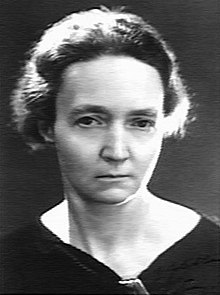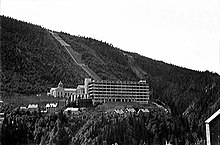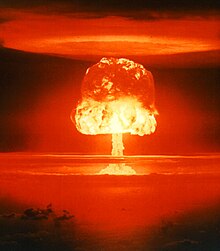Planet Earth/3c. The Chart of the Nuclides
An Invasion
[edit | edit source]On April 9th, 1940, news came over the radio that Nazi Germany had invaded neutral Norway. Leif Tronstad was teaching his chemistry class at the Norwegian Institute of Technology in Trondheim in the northern part of the country, when the news arrived. As a military trained officer Leif Tronstad was trained in weapons combat, and upon hearing the news informed his students that they were now at war, and to report to the nearest military station and take up arms. He and his family left Trondheim, making the six-hour drive south to Oslo to help defend the country, but half way there, the terrible news arrived that Oslo had been overtaken by the Nazis. He took shelter in Dovre Mountains, in the rugged mountainous region in the Rondane National Park. Here he trained volunteers in the use of rifles to defend the country against the invasion. Leif Tronstad was a well-liked professor of chemistry, and had been working on a newly discovered substance. A substance that would alter the course of World War II, and lead to the creation of atomic weapons. In May of 1940, Leif Tronstad had learned that the plant which produced this substance for his lab was now under Nazi control, and that they had ordered increased production from the captured Norwegian operators. The substance was called an isotope, and it does not appear on the periodic table of elements.
What is an isotope?
[edit | edit source]
Twenty-seven years earlier, the chemist Frederick Soddy was attending a dinner party, with his wife’s family in Scotland. During the dinner he got into a discussion with a guest named Margaret Todd, a retired medical doctor. Conversation likely turned to the research Soddy was doing on atomic structure and radioactivity. Soddy had recently discovered that atoms could be identical on the outside, but have differences on their insides. This difference would not appear on standard periodic tables which arrange elements by the number of electrons and protons, and that he was trying to come up with a different way to arrange these new substances. Margaret Todd suggested the term Isotope for these substances, Iso- meaning same, and -tope meaning place. Soddy liked the term, and published a paper late that year using the new term isotope, to denote atoms that differ only in the number of neutrons in a nucleus, but had the same number of protons.
Protons and neutrons exist only within the center of an atom, in the nucleus of atoms, and are called nuclides. An arguably better way to organize the different types of atoms is to chart the number of protons (Z) and number of neutrons (N) inside the nucleus of atoms, (see https://www.nndc.bnl.gov/ for interactive chart). Unlike a periodic table of elements, every single type of atom can be plotted on such a chart, including atoms that are not seen in nature or are highly unstable (radioactive). This type of chart is called the chart of the nuclides.

For example, we can have an atom with 1 proton and 0 neutrons, which is called hydrogen. However, we can also have an atom with 1 proton and 1 neutron, which is called hydrogen as well. The name of the element only indicates the number of protons. In fact, you can theoretically have hydrogen with 1 proton and 13 neutrons. However, such atoms do not appear to exist on Earth, because it is nearly impossible to get 13 neutrons to come together given Earth’s pressure and temperatures with a single proton. However, such atoms might exist in extremely dense stars. A hydrogen with 1 proton and 13 neutrons would act similar to normal hydrogen, but would have an atomic mass of 14 (1 + 13), making it much heavier than normal hydrogen, with an atomic mass of only 1. Atomic mass is the total number of protons and neutrons in an atom.
Most charts of the nuclides do not include atoms that have not been observed, however hydrogen with 1 proton and 1 neutron has been discovered, which is called an isotope of hydrogen. Isotopes are atoms with the same number of protons but different numbers of neutrons. Isotopes can be stable or unstable (radioactive). For example, hydrogen has two stable isotopes, atoms with 1 proton and 0 neutrons, and atoms with 1 proton and 1 neutron, but atoms with 1 proton and 2 neutrons are radioactive. Note that atomic mass differs depending on the isotope, such that we could call a hydrogen isotope with 1 proton and 0 neutrons (with 1 atomic mass) light, compared to an isotope of hydrogen with 1 proton and 1 neutron (with 2 atomic mass) heavy. Scientists will often refer to isotopes as either light or heavy, or by a superscript prefix, such as 1H and 2H, where the superscript prefix indicates the atomic mass.

In 1931, Harold Urey and his colleagues Ferdinand G. Brickwedde and George M. Murphy at the University of Chicago isolated heavy hydrogen (2H), by distilling liquid hydrogen over and over again to purify the liquid hydrogen to contain more of the heavy hydrogen. In discovering heavy hydrogen, Harold Urey named this type of atom, deuterium (sometimes abbreviated as D). Only isotopes of hydrogen are named, all other elements are known only by their atomic mass number, such as 14Carbon (i.e. carbon-14). The number indicates the atomic mass which is the number of protons and number of neutrons, so 14C (carbon-14) has 6 protons and 8 neutrons (6+8 = 14).
Hydrogen that contains 1 proton, and hydrogen that contains 1 proton and 1 neutron will behave similarly in their bonding properties to other atoms and are difficult to tell apart. Hydrogen no matter the number of neutrons will have 1 electron to equally matching the number of protons.
They do, however have slightly different physical properties because of the difference in mass. For example, 1H, will release 7.2889 Δ(MeV), while 2H (deuterium) will release 13.1357 Δ(MeV), slightly more energy when subjected to photons, due to the fact that the nucleus of the atom contains more mass, and the electron orbital shells are pulled a few Planck’s lengths closer to the nucleus in deuterium than typical hydrogen. The excited electrons will have farther to fall and will release more energy. These slight differences in chemical properties allows isotopes to undergo fractionation. Fractionation is the process of changing the abundance or ratio of various isotopes within a substance, by either enriching or depleting various isotopes in a substance.
Heavy Water
[edit | edit source]Water that contains deuterium, or heavy hydrogen has a higher boiling temperature of 101.4 degrees Celsius (at 1 atmosphere of pressure) compared to normal water that boils at 100 degrees Celsius (at 1 atmosphere of pressure). Deuterium is very rare, accounting for only 0.0115% of hydrogen atoms, so to isolate deuterium would require boiling away a lot of water, and keeping the last remaining drops each time, over and over again to increase the amount of deuterium in the water. Heavy water is expensive to make, because it requires so much normal water and distilling it over and over again. This is a process of fractionation.

In 1939 deuterium was discovered to be important in the production of plutonium-239 (239Pu), a radioactive isotope used to make atomic weapons. In an article published in the peer-reviewed journal Nature in 1939, the daughter of Marie Curie, Irène Joliot-Curie and her husband Frédéric Joliot-Curie described how powerful plutonium-239 could be, and how it could be made from uranium using deuterium to moderate free neutrons. The article excited much interest in Nazi Germany, and a campaign was made to produce deuterium. Deuterium bonded to oxygen in water molecules is called heavy water. In 1940 Germany invaded Norway and captured the Vemork power station at the Rjukan waterfall in Telemark, Norway, which had produced deuterium for Leif Tronstad’s lab, but now was capable of producing deuterium for the Germans in the production of the isotope plutonium-239 (239Pu).
Leif Tronstad needed to warn the world that Germany would soon have the ability to make plutonium-239 (239Pu) bombs. But the fighting across Norway was going poorly, as soon the city of Trondheim in the north surrendered, and Leif Tronstad was now a resistance fighter in a country overrun by Nazi Germany. He sent a coded message to Britain warning them of the increased production of deuterium by the Germans. But he was unable to verify the message was received, so he had to escape Norway and warn the world. Leif Tronstad left his family’s cabin on skis and made his way over the Norwegian border with Sweden, and found passage to England. Once in England his warning was received with grave concern by Winston Churchill, who would later write “heavy water – a sinister term, eerie, unnatural, which began to creep into our secret papers. What if the enemy should get the atomic bomb before we did! We could not run the mortal risk of being outstripped in this awful sphere.”
The Race for the Atomic Bomb
[edit | edit source]
Leif Tronstad wanted to lead the mission back to Norway, but was commanded by the British to train Norwegian refugees instead of returning for the impossible mission himself. In 1941 Harold Urey visited Britain where Leif Tronstad pushed Urey to convince President Franklin Roosevelt that the Allies needed to develop an atomic weapon before the Germans did. The captured Norsk Hydro heavy water production plant at Vemork, Norway, gave Nazi Germany a head start. The American military wanted to bomb the plant from the air, which was fortified under seven stories of concrete walls. Leif Tronstad pleaded not to bomb the plant and risk killing civilians because the plant also produced anhydrous ammonia which is extremely explosive. In November of 1942 the first mission was sent to Norway, led by two groups of commandoes. When the second group’s planes drifted off course in bad weather and crashed, most of the commandoes were killed in the crash, and the survivors executed by German soldiers. The first group, which had parachuted into the frozen terrain were now isolated and had to face a harsh winter alone dodging German forces patrolling the neighboring mountains and starvation. The Germans were now also alarmed that an attack was imminent. In February of 1943 a Norwegian special operations team parachuted in behind enemy lines, and relocated the stranded team in the mountains. In the cloak of the night, the team scaled the rock cliffs of the mountainous valley and broke into the manufacturing room of the plant. With plastic explosives the team blew up the room, and fled over the frozen mountainous landscape. The mission was a success, however in the summer of 1943 the plant was repaired. Bombing raids by the American Air Force took out the city. The remaining produced heavy water was to be transported back to Germany, but the boat carrying it was blown up in an act of sabotage in February of 1944. By October of 1944, Leif Tronstad returned to fight in Norway as a resistance fighter. Sadly, he was killed in action in March 1945, a few months before the first atomic bombs were used on the Japanese cities of Hiroshima and Nagasaki in August of 1945 by Allied forces. The atomic bombs killed around 200,000 people, bringing a dramatic end to the war.
-
Atomic explosion over Hiroshima, killing over 66,000 people
-
Atomic explosion over Nagasaki, killing over 80,000 people.
The Hydrogen Bomb
[edit | edit source]Knowledge of isotopes and understanding how to the read the chart of the nuclides you can understand the frightening nature of atomic power. For example, there is another type of isotope of hydrogen that contains 1 proton and 2 neutrons, called tritium (3H), which has an atomic mass of 3. Unlike deuterium which is stable, tritium is very radioactive, and will decay within a few years, with a half-life of 12.32 years. Half-life is the length of time for half of the atoms to decay, so in 12.32 years, 50% of the atoms will remain, in 24.64 years, only 25% of the atoms will remain, and each 12.32 years into the future, the percentage of remaining tritium will decrease by one half. As a very radioactive isotope, tritium is made inside of hydrogen atomic bombs (H-Bombs) through a process of fission of the stable isotope 6-Lithium (6Li) with free neutrons, which acts like a catalyst by increasing energy released during this decay. In nature, tritium does not exist because it decays so quickly, but is a radioactive component of nuclear fall-out in the much more powerful H-bombs or Hydrogen-Bombs first tested after the war in 1952.

Are there hydrogen atoms with 1 proton and 3 neutrons? No, as it appears that atoms with this configuration cannot exist, hydrogen atoms with 3, 4, 5 and 6 neutrons decay so quickly that it is nearly impossible to detect them. The energy released can be measured when hydrogen atoms are bombarded by neutrons, but these atoms are so unstable they cannot exist for any length of time. In fact, for most proton and neutron combinations there are no existing atoms in nature. The number of protons and neutrons appears to be fairly equal, although the larger the atom, the more neutrons are present. For example, plutonium contains 94 protons, the greatest number of protons in a naturally occurring element, but contains between 145 and 150 neutrons to hold those 94 protons together, and even with these neutrons, all isotopes of plutonium are radioactive, with the radioactive 244Pu isotope having the longest half-life of 80 million years. Oganesson (294Og) is the largest isotope ever synthesized and has 118 protons and 176 neutrons (118+176 = 294), but has a half-life of only 0.69 microseconds!
There are 252 isotopes of elements that do not decay and are stable isotopes. The largest stable isotope was thought to be 209Bi, but recently it has been discovered to decay very very slowly with a half-life that is more than a billion times the age of the universe. The largest stable isotope known is 208Pb (lead), which has 82 protons and 126 neutrons. There are actually three stable isotopes of lead, 206Pb, 207Pb and 208Pb, all appear not to decay over time.
| Previous | Current | Next |
|---|---|---|

